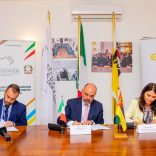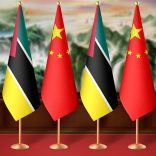Sasol carries out experimental loading of cooking gas produced in Mozambique - AIM
Mozambique: REN stake in Cahora Bassa important for Portugal – HCB chair

The chairman of HCB gave an interview to Lusa on the sidelines of his participation in the II CPLP Energy Conference (pictured), which took place in Estoril, Portugal, from 27 to 28 May 2025. [Photo: Hidroeléctrica de Cahora Bassa ]
The Chairman of the Board of Directors of Hidroelétrica de Cahora Bassa said on Thursday that REN’s 7.5% stake in that Mozambican company is “important” for Portugal’s position in the country and for the dividends that the Portuguese company receives.
“I think it is important from the point of view of Portugal’s position in the former colonies and also from the point of view of some revenue, because the dividends that the company has paid, even for that 7.5%, have been significant for REN,” said Tomás Matola, in an interview with Lusa in Estoril, on the sidelines of the II CPLP Energy Conference.
Fifty years after the country’s independence, the chairman of the board of directors of Mozambique’s largest hydroelectric company highlighted how the reversal process was carried out, with control passing from HCB and its Portuguese management to Mozambicans in 2007, when the Portuguese company REN – Redes Energéticas Nacionais reduced its stake to 7.5%.
There was a transfer of knowledge from REN. Since then, given that REN has a position, albeit not an executive one, on the board of directors, we have (continued to) exchange experience and strategic cooperation, Tomás Matola said.
“Management and operation are carried out by Mozambicans, because there was indeed a good transfer of knowledge,” he stressed, knowledge that was also important for the subsequent development of other energy projects in Mozambique.
“There has been capacity building in Mozambique, both on the part of HCB and on the part of Eletricidade de Moçambique [EDM],” he added, pointing to the expansion and modernisation of the power transmission system as an example.

On the verge of celebrating its 50th anniversary, Cahora Bassa is no longer the only hydroelectric plant in the country, which now has “small hydroelectric plants.” Still, it remains “the guardian of knowledge from the point of view of hydroelectric power generation,” he emphasised.
The “great challenge” at the moment is to respond to “growing domestic demand” due to the development of Mozambique’s economy and industrialisation, and to “regional demand” because the region has “an energy deficit aggravated by South Africa”, but at the same time, it is “an opportunity for Cabora Bassa to grow and expand”, Matola pointed out.
For this reason, Cabora Bassa, which today still “has the same production capacity left by the Portuguese,” has expansion projects, he stressed.
One of these projects is the North Power Plant, which is currently under study, but which Matola believes will be “approved by the cabinet this year,” with construction expected to begin within two years and continue until 2031 or 2032.
READ: Mozambique: Plan revived to build second Cahora Bassa hydroelectric plant
For this investment, HCB “will open up capital only for Central Norte, in a “project finance” perspective, at 40%,” with the remaining 60% remaining in the hands of HCB, which will use its own resources but will also have to resort to debt to ensure the necessary financing.
Additionally, a photovoltaic energy project is planned for the initial generation of 400 megawatts of solar energy, currently in the “pre-study” phase, with the potential to expand capacity and be open to private operators. In this company, HCB acknowledges that it will retain between 5% and 10% of the capital.

On 12 May this year, Hidroelétrica de Cahora Bassa announced in a public notice that it would distribute 7.4 billion meticais (€102.6 million) in dividends to shareholders, including REN, at a value of 0.28 meticais (0.4 euro cents) per share.
READ: Mozambique: Cahora Bassa Hydroelectric distributes €100 million in dividends
HCB is a private limited company, 85% owned by the state-owned Companhia Elétrica do Zambeze and 7.5% by REN, with the company holding 3.5% of its own shares and the remaining capital in the hands of Mozambican citizens, companies and institutions.
The Cahora Bassa reservoir is the fourth largest in Africa, with a maximum length of 270 kilometres and 30 kilometres between banks, covering 2,700 square kilometres and with an average depth of 26 metres. It employs almost 800 workers and is one of the largest electricity producers in southern Africa, supplying neighbouring countries.
The afternoon of the second day of the conference featured technical sessions focused on topics such as fuel diversification, the modernisation of electrical systems, and pathways toward decarbonisation and a green economy. pic.twitter.com/qTH7FGDFM2
— ALER (@ALER_renovaveis) May 28, 2025
O Secretário Executivo da CPLP, Zacarias da Costa, participou na sessão de abertura da «II Conferência de Energia da CPLP», a decorrer nos dias 27 e 28 de maio de 2025, no Centro de Congressos do Estoril, em Cascais, Portugal.#CPLP #Energia pic.twitter.com/FgASqis5FT
— CPLP (@_CPLP) May 28, 2025
Os ministros da Energia dos Estados-Membros da CPLP, ou seus representantes, integraram um painel de alto nível na «II Conferência de Energia da CPLP», a decorrer nos dias 27 e 28 de maio de 2025, no Centro de Congressos do Estoril, em Cascais, Portugal.#CPLP #Energia pic.twitter.com/Z8h5cj3gv4
— CPLP (@_CPLP) May 28, 2025












Leave a Reply
Be the First to Comment!
You must be logged in to post a comment.
You must be logged in to post a comment.